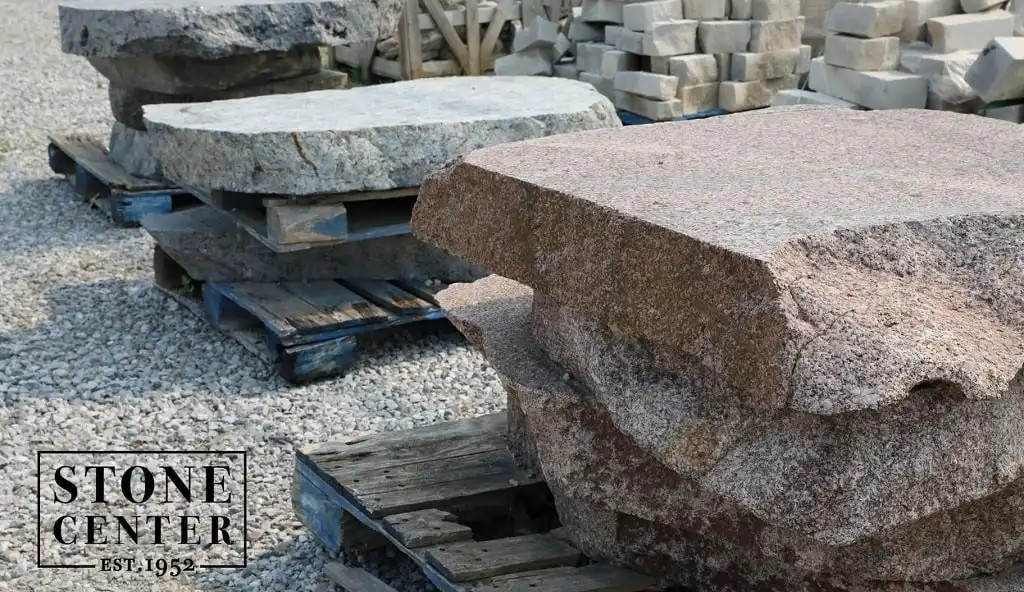Granite’s appearance in rock formations is defined by its speckled, crystalline texture, a characteristic you can explore further at rockscapes.net. This guide will dive deep into how to identify granite, its unique characteristics, and where it fits within various landscape designs, helping you make informed choices for your projects. Discover the beauty and versatility of granite and other natural stone selections for your landscapes.
1. What Exactly is Granite?
Granite is a coarse-grained igneous rock primarily composed of quartz and feldspar, with minor amounts of mica, amphiboles, and other minerals. This composition gives granite its distinctive appearance and properties. According to research from Arizona State University’s School of Earth and Space Exploration, the slow cooling of magma deep beneath the Earth’s surface allows for the formation of large crystals, which are visible to the naked eye and contribute to granite’s unique texture.
1.1 How Does Granite Form?
Granite forms from the slow cooling and crystallization of magma (molten rock) beneath the Earth’s surface. This slow cooling process allows large crystals to form, giving granite its characteristic coarse-grained texture.
1.2 What is the Mineral Composition of Granite?
Granite typically contains 20-60% quartz, 35-65% feldspar, and 5-15% mica. The specific minerals and their proportions can vary, leading to a wide range of colors and textures.
1.3 Where is Granite Found?
Granite is found in continental crust throughout the world, particularly in mountainous regions and ancient shield areas. Major granite producing countries include Brazil, China, India, Spain, Italy, and the United States.
2. What Does Granite Look Like in Rocks?
Granite’s appearance is characterized by its coarse-grained texture and speckled appearance, with visible crystals of quartz, feldspar, and mica. The color of granite can vary widely depending on the mineral composition.
2.1 What are the Common Colors of Granite?
Granite commonly appears in shades of gray, pink, white, and black, but can also exhibit green, blue, and brown hues. The color is influenced by the types and proportions of minerals present.
2.2 What are the Textural Characteristics of Granite?
Granite has a phaneritic texture, meaning its crystals are large enough to be seen without magnification. The crystals are typically interlocking and randomly oriented.
2.3 How Can You Identify Granite by its Appearance?
You can identify granite by its coarse-grained texture, speckled appearance, and hardness. It is also resistant to scratching with a steel knife.
 Granite rock close-up showing visible crystals
Granite rock close-up showing visible crystals
3. What are the Different Types of Granite?
Granite is classified based on its mineral composition, texture, and origin. Some common types include:
- Alkali Feldspar Granite: Rich in alkali feldspar, giving it a pink or reddish hue.
- Granodiorite: Contains more plagioclase feldspar than alkali feldspar.
- Tonalite: Primarily composed of plagioclase feldspar, quartz, and amphibole.
3.1 How Does Mineral Composition Affect Granite’s Appearance?
The minerals present in granite determine its color, texture, and overall appearance. For instance, a high concentration of potassium feldspar can result in a pink granite, while the presence of dark minerals like biotite mica can create a speckled black and white appearance.
3.2 How Does Texture Vary Among Different Granite Types?
Texture in granite can range from coarse-grained to porphyritic, where large crystals (phenocrysts) are embedded in a finer-grained matrix. These textural variations depend on the cooling rate and conditions during the granite’s formation.
3.3 Can You Give Examples of Different Granite Types and Their Unique Appearances?
- Ubatuba Granite: Known for its dark green or black color with shimmering gold or silver flecks.
- Giallo Ornamental Granite: Features warm beige and gold tones with brown and gray veining.
- Baltic Brown Granite: Displays a mix of brown and black crystals with large, rounded feldspar inclusions.
4. Where Can Granite be Used in Landscaping?
Granite is a versatile material for landscaping due to its durability, weather resistance, and aesthetic appeal. It can be used in:
- Pathways and Walkways: Granite pavers or gravel provide a durable and attractive surface.
- Retaining Walls: Granite blocks can create sturdy and visually appealing retaining walls.
- Water Features: Granite boulders and rocks can add a natural and dramatic element to ponds and waterfalls.
- Decorative Accents: Granite can be used as accents in gardens, rock gardens, and other landscape features.
4.1 How Can Granite be Used to Create Pathways and Walkways?
Granite pavers and gravel offer a durable, slip-resistant, and aesthetically pleasing option for pathways and walkways. They can withstand heavy foot traffic and harsh weather conditions, making them ideal for both residential and commercial landscapes.
4.2 How Can Granite be Used in Retaining Walls?
Granite blocks provide structural integrity and a natural look for retaining walls. Their strength and resistance to weathering ensure long-lasting performance and minimal maintenance.
4.3 What are Some Creative Ways to Incorporate Granite into Water Features?
Granite boulders and rocks add a natural and dramatic touch to water features. They can be arranged to create waterfalls, ponds, and streams, enhancing the visual appeal and tranquility of the landscape. According to landscape architects, the use of granite in water features not only adds aesthetic value but also promotes ecological balance by providing habitats for aquatic life.
5. What are the Benefits of Using Granite in Landscaping?
Granite offers numerous benefits for landscaping applications:
- Durability: Granite is highly resistant to weathering, erosion, and physical damage.
- Low Maintenance: Granite requires minimal maintenance, saving time and money.
- Aesthetic Appeal: Granite adds a natural and elegant touch to any landscape design.
- Versatility: Granite can be used in a wide range of applications, from pathways to water features.
- Sustainability: Granite is a natural and sustainable material that can last for generations.
5.1 How Does Granite’s Durability Benefit Landscaping Projects?
Granite’s exceptional durability ensures that landscaping projects withstand the test of time. Its resistance to weathering, erosion, and physical damage reduces the need for frequent repairs and replacements, making it a cost-effective choice in the long run.
5.2 What are the Long-Term Cost Savings of Using Granite?
The initial investment in granite may be higher than some alternatives, but its longevity and low maintenance requirements translate to significant long-term cost savings. Reduced maintenance, fewer repairs, and the elimination of replacement costs contribute to its economic value.
5.3 How Does Granite Contribute to Sustainable Landscaping Practices?
Granite is a natural and sustainable material that aligns with environmentally friendly landscaping practices. Its durability ensures a long lifespan, reducing the demand for new materials and minimizing waste. Additionally, granite is recyclable and can be repurposed at the end of its life, further enhancing its sustainability.
6. How Does Granite Compare to Other Types of Rock Used in Landscaping?
When considering materials for landscaping, granite is often compared to other types of rock such as limestone, sandstone, and slate. Each of these materials has its own unique characteristics and benefits.
6.1 Granite vs. Limestone: What are the Key Differences?
- Composition: Granite is an igneous rock composed of quartz and feldspar, while limestone is a sedimentary rock composed of calcium carbonate.
- Durability: Granite is generally more durable and resistant to weathering than limestone.
- Appearance: Granite has a coarse-grained, speckled appearance, while limestone has a smoother, more uniform texture.
- Applications: Granite is commonly used for countertops, paving, and retaining walls, while limestone is often used for cladding, paving, and decorative features.
6.2 Granite vs. Sandstone: What are the Key Differences?
- Composition: Granite is an igneous rock, while sandstone is a sedimentary rock composed of sand grains.
- Durability: Granite is more durable and resistant to weathering than sandstone.
- Appearance: Granite has a crystalline, speckled appearance, while sandstone has a more granular texture and often displays visible layers.
- Applications: Granite is used for structural and decorative purposes, while sandstone is often used for paving, cladding, and garden walls.
6.3 Granite vs. Slate: What are the Key Differences?
- Composition: Granite is an igneous rock, while slate is a metamorphic rock formed from shale or mudstone.
- Durability: Granite is highly durable and resistant to weathering, while slate is more prone to chipping and cracking.
- Appearance: Granite has a coarse-grained texture with visible crystals, while slate has a fine-grained, layered appearance.
- Applications: Granite is used for countertops, paving, and structural elements, while slate is commonly used for roofing, paving, and wall cladding.
7. Where Can You Purchase Granite for Your Landscaping Projects?
Granite can be purchased from various sources, including:
- Stone Quarries: Direct from the source, offering a wide selection of granite in various sizes and shapes.
- Landscape Supply Stores: Retail outlets that specialize in landscaping materials, including granite.
- Home Improvement Centers: Large retail stores that carry a limited selection of granite products.
- Online Retailers: Online stores that offer a convenient way to purchase granite, with delivery options available.
7.1 What Should You Look for When Selecting a Granite Supplier?
When selecting a granite supplier, consider the following factors:
- Quality: Ensure the granite is of high quality and meets your project requirements.
- Selection: Choose a supplier with a wide selection of granite types, colors, and sizes.
- Price: Compare prices from different suppliers to find the best value for your money.
- Reputation: Select a supplier with a good reputation for customer service and reliability.
- Location: Choose a supplier that is conveniently located and offers delivery options.
7.2 What are the Typical Costs Associated with Purchasing Granite?
The cost of granite varies depending on the type, size, and quantity. As a general guide:
- Granite Pavers: $5 to $15 per square foot.
- Granite Boulders: $100 to $1000 per boulder, depending on size and weight.
- Granite Gravel: $50 to $150 per ton.
7.3 What are Some Reputable Granite Suppliers in the USA?
Some reputable granite suppliers in the USA include:
- Rockscapes.net: Offers a wide selection of granite and other natural stones.
Address: 1151 S Forest Ave, Tempe, AZ 85281, United States
Phone: +1 (480) 965-9011
Website: rockscapes.net - Coldspring: A leading quarrier and fabricator of natural stone products.
- Polycor: One of the largest natural stone companies in North America.
8. How Do You Maintain Granite in Landscaping?
Granite is a low-maintenance material, but some basic care can help preserve its appearance and longevity.
8.1 What are the Best Practices for Cleaning Granite in Outdoor Settings?
- Regular Sweeping: Sweep granite surfaces regularly to remove dirt and debris.
- Hose Down: Rinse granite with a garden hose to remove loose dirt and stains.
- Mild Soap: Use a mild soap and water solution to clean stubborn stains.
- Avoid Harsh Chemicals: Avoid using harsh chemicals or abrasive cleaners that can damage the granite surface.
8.2 How Can You Prevent Staining and Damage to Granite Surfaces?
- Sealants: Apply a sealant to protect granite surfaces from stains and water damage.
- Prompt Cleanup: Clean up spills and stains promptly to prevent them from penetrating the granite.
- Protective Mats: Use protective mats or coasters under pots and planters to prevent staining.
8.3 Are There Any Specific Products Recommended for Granite Maintenance?
- Granite Cleaners: Use cleaners specifically formulated for granite to avoid damaging the surface.
- Granite Sealers: Apply a high-quality granite sealer to protect against stains and water damage.
- Soft Brushes: Use soft brushes or cloths to avoid scratching the granite surface during cleaning.
9. What are Some Design Ideas for Landscaping with Granite?
Granite can be incorporated into a variety of landscape designs to create unique and visually appealing spaces.
9.1 How Can You Create a Natural Stone Garden Using Granite?
- Rock Gardens: Arrange granite boulders and rocks to create a natural rock garden.
- Alpine Gardens: Incorporate granite into alpine gardens with drought-tolerant plants.
- Zen Gardens: Use granite to create a minimalist and serene Zen garden.
9.2 How Can Granite be Used to Enhance Curb Appeal?
- Entryways: Use granite pavers or steps to create an inviting entryway.
- Mailbox Posts: Install granite mailbox posts for a durable and elegant touch.
- Address Markers: Create granite address markers for a unique and personalized look.
9.3 What are Some Trends in Granite Landscaping Design?
- Natural Stone Water Features: Granite is increasingly used in natural stone water features, creating tranquil and visually stunning environments.
- Sustainable Landscaping: Granite is a popular choice for sustainable landscaping designs due to its durability and low maintenance requirements.
- Mixed Material Designs: Combining granite with other materials like wood, metal, and concrete is a growing trend in landscape architecture.
10. What are Some Common Mistakes to Avoid When Using Granite in Landscaping?
While granite is a versatile and durable material, there are some common mistakes to avoid when using it in landscaping projects.
10.1 What are the Potential Pitfalls of Improper Granite Installation?
- Uneven Surfaces: Ensure granite surfaces are level and properly installed to prevent tripping hazards.
- Poor Drainage: Provide adequate drainage to prevent water from pooling on granite surfaces, which can lead to staining and damage.
- Inadequate Support: Provide adequate support for granite structures, such as retaining walls, to prevent collapse or instability.
10.2 How Can You Avoid Color and Texture Clashes in Your Design?
- Plan Ahead: Carefully plan your design and select granite colors and textures that complement your existing landscape.
- Sample Viewing: View granite samples in person to ensure they meet your expectations.
- Professional Advice: Consult with a landscape designer to help you choose the right granite for your project.
10.3 What are the Environmental Considerations When Using Granite?
- Quarrying Impacts: Be aware of the environmental impacts of granite quarrying, such as habitat destruction and water pollution.
- Transportation Costs: Consider the transportation costs and carbon footprint associated with transporting granite from distant quarries.
- Sustainable Sourcing: Choose granite from suppliers that follow sustainable quarrying practices.
FAQ About Granite in Landscaping
Here are some frequently asked questions about using granite in landscaping:
- Is granite a good choice for landscaping in hot climates?
Yes, granite is an excellent choice for hot climates due to its durability and resistance to weathering. - How does granite hold up in areas with heavy rainfall?
Granite is highly resistant to water damage and erosion, making it suitable for areas with heavy rainfall. - Can granite be used in saltwater environments?
Yes, granite is resistant to saltwater corrosion and can be used in coastal landscapes. - How often should granite surfaces be sealed?
Granite surfaces should be sealed every 1-3 years, depending on the level of exposure and wear. - Is granite slippery when wet?
Polished granite can be slippery when wet, but textured or flamed granite provides better traction. - Can granite be painted or stained?
Granite can be painted or stained, but it is generally not recommended as it can alter its natural appearance and durability. - How can you remove graffiti from granite surfaces?
Graffiti can be removed from granite surfaces using specialized graffiti removers and pressure washing. - Is granite recyclable?
Yes, granite is recyclable and can be repurposed for other landscaping or construction projects. - How does the cost of granite compare to other landscaping materials like concrete or brick?
Granite is generally more expensive upfront compared to concrete or brick but offers better longevity, natural beauty and low maintenance, which may provide long-term cost savings. - Can I use granite in a raised garden bed?
Yes, granite can be used to construct durable and aesthetically pleasing raised garden beds.
Choosing granite for your landscaping projects ensures a blend of durability, beauty, and timeless appeal, enhancing your outdoor spaces for years to come.
Ready to transform your landscape with the enduring beauty of granite? Explore our extensive selection of granite options and discover innovative design ideas at rockscapes.net. Contact our experts today for personalized advice and let us help you bring your vision to life. Visit us at 1151 S Forest Ave, Tempe, AZ 85281, United States, call +1 (480) 965-9011, or explore our website at rockscapes.net to start your landscaping journey today!

